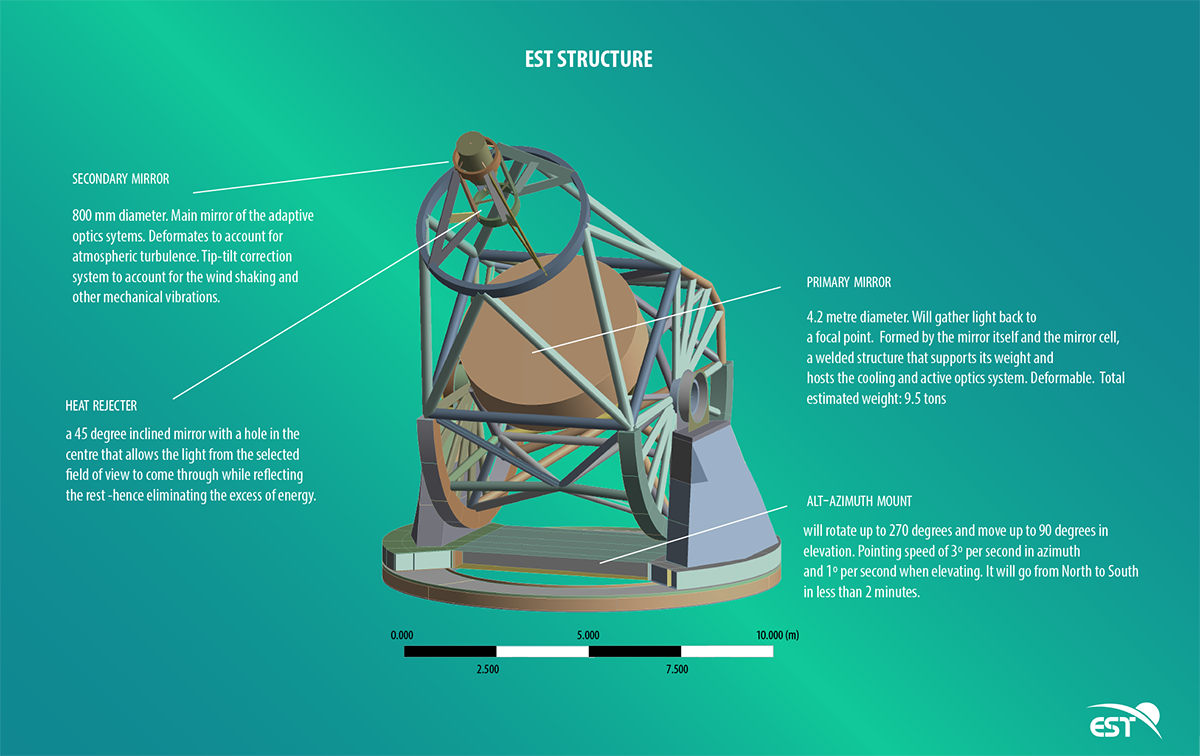The telescope structure is one of the main systems of the European Solar Telescope. It supports the six mirrors of the telescope, the heat rejecter and all the auxiliary systems. It will also have a very fast mount, able to go from North to South in less than 2 minutes.
 3D rendering of the telescope structure and key elements on it
3D rendering of the telescope structure and key elements on it
When talking about telescopes, we tend to pay attention to mirrors and sizes, forgetting that these optical elements need supporting structures.
The EST mechanical structure is an impressive work of engineering, able to support six mirrors (M1, M2, and the four mirrors used to get rid of instrumental polarization), the heat rejecter, and all their auxiliary systems. Since the EST primary mirror will be above the elevation axis (unlike in most telescopes), counterweights are also included. The final weight of the structure amounts to 150 tons.
The structure also allows for an accurate pointing of the telescope. EST will have an alt-azimuth configuration, able to rotate up to 270 degrees and move up to 90 degrees in elevation (allowing it to point to the zenith, for example). This will allow scientists to track the Sun from sunrise to sunset. In spite of its weight, it is a very fast mechanism: with a pointing speed of 3º per second in azimuth and 1º per second in elevation, it can go from North to South in less than 2 minutes.
A wind-proof design
The design of the structure is, as everything else in the telescope, driven by the need to minimise the perturbations induced by wind and heat.
The optical design of the EST maximises refrigeration by air. This is especially notorious in the lack of a dome: there will only be a lightweight enclosure that will remain open during the observations.
Unfortunately, this design does not only provide better refrigeration but makes the telescope more prone to wind-induced vibrations that can affect the tracking accuracy. “This means that the structure and the optical elements need to be rigid enough to minimise wind vibrations, and account for them”, explains Juan Cózar, a member of the EST Project Office. “This is a cost-efficiency decision: even though building such a telescope will be more expensive, operational costs will be cheaper in the long run", points out Cózar.
The structure will rest on a pier, inside which there will be a long vacuum vessel that will transfer the light into the Coudé room, a temperature and humidity controlled chamber where the instrumentation will be placed. This pier will have a conical shape to reduce the wind load and the thermal turbulence. Its foundations will be separated from those of the telescope's adjacent building (that will host machinery, workshops, and offices) to ensure that vibrations from the building won't affect the observations.
